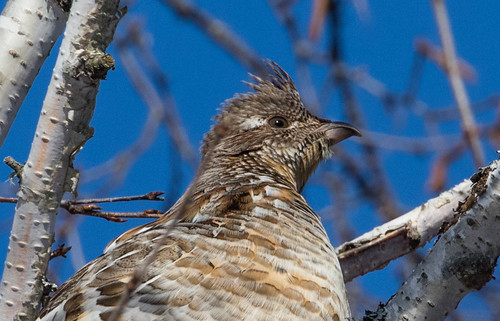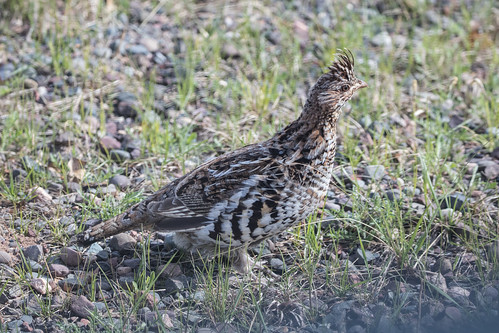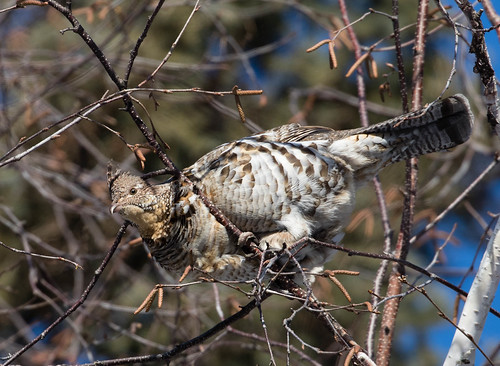(This blogpost is from a radio program from October 29, 2008)
Every now and then when I’m walking through the north woods, deep in thought, I’m suddenly startled by a burst of wings in a thunderous explosion, often just inches from my feet. Within a second I’m over the surprise, but it takes longer to get over the thrill of my close encounter with a Ruffed Grouse. Every single feather of these exquisite birds is a work of art, and together the feathers provide the bearer with perfect camouflage, rugged insulation, and matchless beauty.
Ruffed Grouse have a few quiet vocalizations, but the sounds they’re most famous for aren’t vocal. That characteristic thunder of wings that startles anyone who gets too close affords them a moment or two of protection against predators. The roaring explosiveness results from the powerful white muscle fibers that compose the birds’ breast muscles. The mighty burst when a grouse flushes is short-lived, the wings quickly exhausted. It will be several minutes before the grouse is again capable of such an effort, until the relatively small blood supply to the muscles washes away the lactic acid that built up in flight. Meanwhile, the grouse lurks on the ground, protected by cryptic coloration.
The other sound grouse are famous for is their distinctive drumming sound, which almost sounds as if someone had dropped a bowling ball in the woods–it bounces slowly at first but speeds up into a whir. People once believed this sound was produced by the grouse’s wingtips beating the drumming log, or that the bird thumped its wings against its breast, Tarzan-like. But early one May morning in 1932 in Ithaca, New York, Arthur A. Allen established once and for all how the sound is made. Long before dawn he hid out near a grouse’s drumming log armed with a slow-motion movie camera and sound-recording equipment, and caught a drumming grouse on film. But the stopped frames of the film showed that the grouse stood crosswise on the log, braced on his tail, and cupped his wings, bringing them forward and upward with such force that he compressed a parcel of air between his chest and wings, creating the sound wave without the wings and chest or the wings and log ever touching. The sound is deep—about 40 Hertz, which is at the low range of human hearing and slightly below the hearing range of Great Horned Owls.
In spring, Ruffed Grouse males grow territorial and announce their presence to females via this drumming. In fall, some young males spend a few weeks practicing their drumming skills. Until a bird masters the trick of cupping the air properly, he may simply produce a dull flapping sound, but as with many skills, practice makes perfect. By spring young males may produce as fine a sound as much older males. Females find the drumming sounds irresistible, but don’t bond with or maintain any interest in the males after mating. Females do all the nest-building, incubating, and raising the dozen-or-so chicks. Chicks hatch in synchrony and all leave the nest within 24 hours of the first egg hatching. They quickly imprint on their mother, following her everywhere. Once in a while a bird gets separated from the rest, but its calls and those of its mother usually quickly help them find each other. In very rare cases it joins another female with a brood. Chicks can be independent after about 12 weeks.
The largest cause of mortality for Ruffed Grouse is predation. Among 563 radio-marked grouse with known fates in Wisconsin, 30 percent were killed by hunters, 46 percent were taken by hawks and owls, and 20 percent were killed by small mammals. Their lifespan is less than that of chickadees, which have lived to be over 12 years old—the oldest Ruffed Grouse on record lived to be 8 years old. Fortunately they do produce lots of babies every year, so as long as we protect plenty of quality habitat and are careful about hunting levels, grouse should endure for the foreseeable future.
Aldo Leopold wrote, “Everyone knows…that the autumn landscape in the north woods is the land, plus a red maple, plus a Ruffed Grouse. In terms of conventional physics, the grouse represents only a millionth of either the mass or the energy of an acre yet subtract the grouse and the whole thing is dead.”


